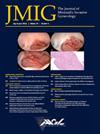Evaluating the Role of Hysteroscopy Guided Biopsy in Triaging Endometrial Intraepithelial Neoplasia for Subspecialty Referral
IF 3.5
2区 医学
Q1 OBSTETRICS & GYNECOLOGY
引用次数: 0
Abstract
Study Objective
To compare the diagnostic accuracy of hysteroscopic sampling versus blind sampling in detecting concurrent endometrial carcinoma (EC) in patients with endometrial intraepithelial neoplasia (EIN).
Design
This is a retrospective cross-sectional cohort study. Statistical data was based on frequency data, with quantitative variables expressed as means and standard deviations. For known confounding variables, univariate and multivariate regression analysis was performed.
Setting
Patients included patients who were diagnosed with EIN in a clinic or operating room setting using hysteroscopy or blind sampling tools.
Patients or Participants
151 patients diagnosed with EIN during endometrial sampling who underwent a hysterectomy within three months in the Mayo Clinic enterprise between January 1, 2018, and January 1, 2023.
Interventions
Those diagnosed with hysteroscopy-directed biopsy (grasp biopsy and global sampling) were compared to blind-sampling methods (pipelle or dilation and curettage) using the pathology results of the hysterectomy specimen as the gold standard comparator.
Measurements and Main Results
The mean (SD) patient age was 60.45 (±11.48) years for the hysteroscopy-directed group (n=76) and 63.95 (±10.73) years for the blind-sampling group (n=75). There was a reduced risk of concurrent EC on the final hysterectomy pathology for women who were diagnosed with EIN via hysteroscopy-directed biopsy (OR=0.44, 95% CI=0.20–0.95, p = 0.033). In univariate analysis, body mass index ≥30 was associated with an elevated risk of EC on final pathology (OR=4.17, 95% CI=1.51-11.51, p = 0.004). The risk of EC was higher in patients >60 years of age (OR=5.56, 95% CI=1.22-35.21, p<0.001). In multivariate analysis, diabetes mellitus was the only independent variable associated with a higher risk of EIN on final pathology (OR=7.01, 95% CI=1.40-35.04, p = 0.018). Age, BMI, and endometrial thickness on pre-biopsy ultrasound were not associated with EC on final hysterectomy pathology on univariate and multivariate analyses.
Conclusion
Hysteroscopic-directed biopsy reduces the risk of missing a concurrent EC during endometrial sampling in women with EIN.
评估宫腔镜引导下活检在分流子宫内膜上皮内瘤变以进行亚专科转诊中的作用
研究目的比较宫腔镜取样与盲法取样在检测子宫内膜上皮内瘤变患者并发子宫内膜癌(EC)方面的诊断准确性。统计数据以频率数据为基础,定量变量以均数和标准差表示。对于已知的混杂变量,进行了单变量和多变量回归分析.Setting患者包括在诊所或手术室环境中使用宫腔镜或盲法取样工具诊断出EIN的患者.Patients or Participants151名患者在子宫内膜取样过程中诊断出EIN,并于2018年1月1日至2023年1月1日期间在梅奥诊所企业中接受了3个月内的子宫切除术。干预措施以子宫切除术标本的病理结果作为金标准比较指标,将宫腔镜引导活检(抓取活检和整体取样)与盲法取样(管式或扩张刮宫)诊断的患者进行比较。测量和主要结果宫腔镜引导组(n=76)患者的平均年龄为60.45(±11.48)岁,盲法取样组(n=75)患者的平均年龄为63.95(±10.73)岁。通过宫腔镜引导活检确诊为EIN的女性在最终子宫切除病理中并发EC的风险较低(OR=0.44,95% CI=0.20-0.95,P=0.033)。在单变量分析中,体重指数≥30与最终病理结果显示的EC风险升高有关(OR=4.17,95% CI=1.51-11.51,p=0.004)。60岁患者的EC风险更高(OR=5.56,95% CI=1.22-35.21,p<0.001)。在多变量分析中,糖尿病是唯一与最终病理结果显示EIN风险较高相关的自变量(OR=7.01,95% CI=1.40-35.04,p=0.018)。在单变量和多变量分析中,年龄、体重指数和活检前超声检查的子宫内膜厚度与最终子宫切除病理结果中的EC无关。
本文章由计算机程序翻译,如有差异,请以英文原文为准。
求助全文
约1分钟内获得全文
求助全文
来源期刊
CiteScore
5.00
自引率
7.30%
发文量
272
审稿时长
37 days
期刊介绍:
The Journal of Minimally Invasive Gynecology, formerly titled The Journal of the American Association of Gynecologic Laparoscopists, is an international clinical forum for the exchange and dissemination of ideas, findings and techniques relevant to gynecologic endoscopy and other minimally invasive procedures. The Journal, which presents research, clinical opinions and case reports from the brightest minds in gynecologic surgery, is an authoritative source informing practicing physicians of the latest, cutting-edge developments occurring in this emerging field.

 求助内容:
求助内容: 应助结果提醒方式:
应助结果提醒方式:


